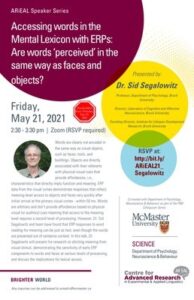By Dr. Sid Segalowitz, May 21, 2021, 2:30 – 3:30 pm
This talk is co-hosted by the Department of Psychology, Neuroscience & Behaviour as part of the PNB Colloquium and ARiEAL Research Centre as part of the ARiEAL Speaker Series. Dr. Sid Segalowitz is a Professor in the Department of Psychology, co-directs the Laboratory of Cognitive and Affective Neuroscience, and was the Founding Director of the Institute for Lifespan Development Research at Brock University. He received his training in developmental psychology with a focus on language and cognitive development, but was quickly captured by the new discoveries of continued brain growth after birth, in what was then the new field of cognitive neuroscience. In 1974, he started at Brock University and began his research based on EEG technology, exploring a number of issues in cognitive information processing and development. Of particular interest has been specific cortical activation markers in the EEG to a variety of psychological factors, including specific stages of processing information presented in words, faces and pictures, to developmental changes in cognition, and to how some of the EEG outcomes are influenced by personality factors. These included studies on the role of the medial prefrontal cortex (mPFC) on attention control as captured in paradigms associated with performance monitoring, with inhibitory control of motor responses, and on specific types of motor learning. These were also related to specific aspects of the person’s personality, including traits of shyness, empathy, impulsivity, conscientiousness, neuroticism, and included some work on the mPFC responses of psychopaths imprisoned for violent crimes. Most recently, Dr. Segalowitz has been involved in developing new mathematical methods of EEG processing to provide cleaner signals which have permitted more effective use of EEG in general, but especially from babies and young children, who often cannot sit still during data acquisition, or where neurological compromise interferes with obtaining clean signals. Of more importance, the new methods also allow researchers to address new and interesting questions about the brain processing of information that was not possible with traditional methods, with applications more recently to new insights about word processing and the nature of the mental lexicon

Expandable List
Words are clearly not encoded in the same way as visual objects, such as faces, tools, and buildings. Objects are directly associated with their referents with physical visual cues that provide affordances, i.e., characteristics that directly imply function and meaning. ERP data from the visual cortex demonstrate responses that reflect meaning-level access to objects and faces very quickly after initial arrival at the primary visual cortex – within 50 ms. Words are arbitrary and don’t provide affordances based on physical visual (or auditory) cues meaning that access to the meaning level requires a second level of processing. However, Dr. Sid Segalowitz and team have found that ERP responses to word reading-for-meaning can be just as fast, even though the words are presented out of sentence context. In this talk, Dr. Segalowitz will present his research on eliciting meaning from visual stimuli, demonstrating the sensitivity of early ERP components to words and faces at various levels of processing, and discuss the implications for lexical access.
